Uploading your files
You can upload files via:
- Browser - simply drag and drop folders or files into your account.
- FTP - a popular method for uploading lots of folders or files.
- S3 - the recommended method for secure uploads or managing files via an API.
Sirv supports all kinds of file including video, PDF, CSS, JavaScript and other static file types. See the full list of list of supported file formats.
Browser upload
All browsers support file uploads to your account and some also support folder uploads.
To upload a file, either drag and drop your images into your account or click the "Upload" button near the top right of your account.FTP upload
To upload by FTP, enter the settings below into your FTP program. Popular programs include FileZilla (Windows/Mac/Linux), Transmit (Mac) or Free FTP (Windows).
- FTP server: ftp.sirv.com
- Your username: Your email address
- Your password: same as your Sirv password
- Encryption: plain FTP (not SFTP/TLS)
If using FileZilla, open Site Manager and setup your account like the screenshot below, then click "Connect":
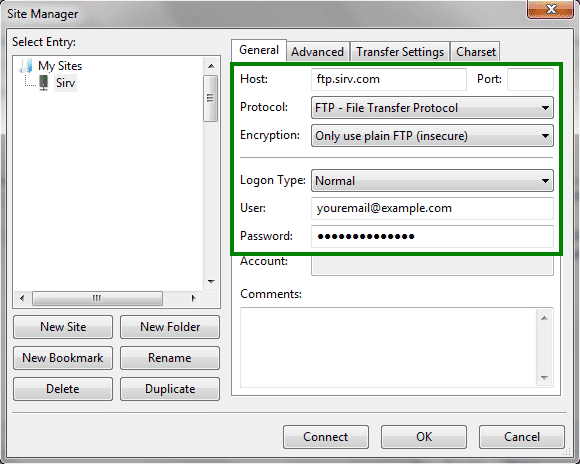
Multiple FTP accounts
If you manage multiple Sirv accounts, you can FTP into another account by using your Sirv email and password and appending the account name to your email address. For example:
- yourname@example.com+otheraccount
This is how the configuration looks in FileZilla:
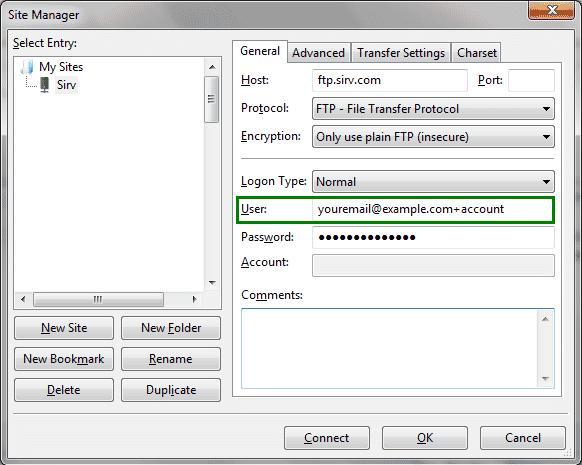
FTP append
Sirv supports the APPE command (append), which can be useful when uploading huge files or if your network connection is unstable. If a connection breaks during an upload, APPE makes the file continue uploading where it left off. Most FTP programs support APPE.
To use APPE in Filezilla, go to Edit > Settings... and set the "File exists action" for Uploads to Resume file. Screenshot:
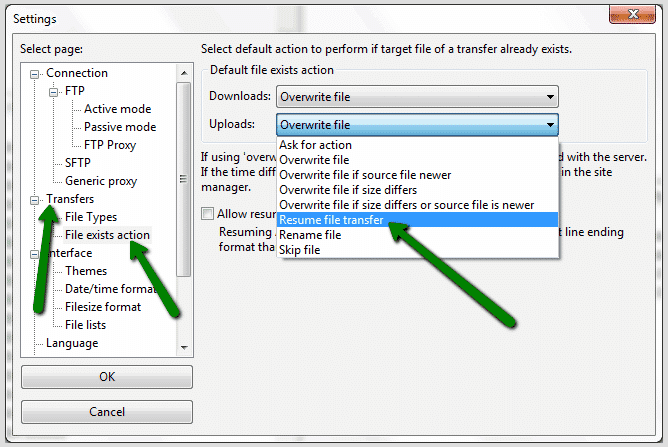
If you have a slow or unstable internet connection, images may not fully upload to Sirv. If Sirv receives only part of an image, the missing part will show as dark grey. You'll see an alert in your Sirv account, recommending that you upload the image again. Simply reupload the image and it will be reprocessed.
If an unstable internet connection leads to numerous partly uploaded images, try zipping your images or using an S3 upload program.
FTP throttling
There's an hourly limit (see below) on the number of files that can be uploaded. If you're hitting your limit, consider throttling FileZilla to upload files slower. Assuming your images are 500 KB each and your FTP limit is 2,000 files per hour, an upload limit of 250 KiB/s will transfer 1,800 files per hour. Adjust the rate as you need.
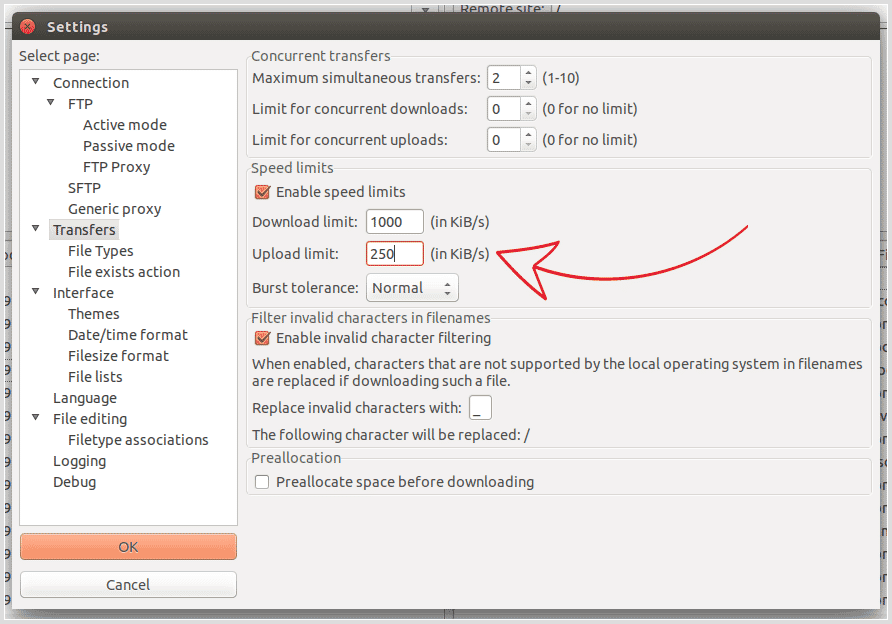
FTP rate limit
You can use FTP to upload large, though limited numbers of files per hour. If you need to upload more files per hour, you can use S3, which has higher limits.
Rate limits for Enterprise and Business accounts:
- FTP uploads per hour: 2,000
- FTP retrieves per hour: 3,000
- FTP deletes per hour: 3,000
- Total FTP operations per hour: 10,000
Rate limits for Free accounts:
- FTP uploads per hour: 300
- FTP retrieves per hour: 1,000
- FTP deletes per hour: 300
- Total FTP operations per hour: 1,000
S3 upload
Sirv supports the Amazon S3 interface, permitting you to upload, download and manage your files with a program that supports S3.
Uploads over S3 use port 443 and are secure (HTTPS). All S3 uploads benefit from integrity checks, allowing interrupted uploads to be resumed (by automatically returning the file MD5 in the ETag header). Multipart uploads are supported, allowing large files to be broken into smaller chunks and then building them together. These benefits make S3 an attractive alternative to FTP.
To configure S3 uploading, you'll need your S3 credentials from your Sirv account and a program that supports S3, such as Cyberduck (Windows/Mac/Linux).
Follow our step-by-step instructions to configure Cyberduck. Once configured, set Cyberduck to repeat failed uploads, by ticking the "Repeat failed networking tasks" box:
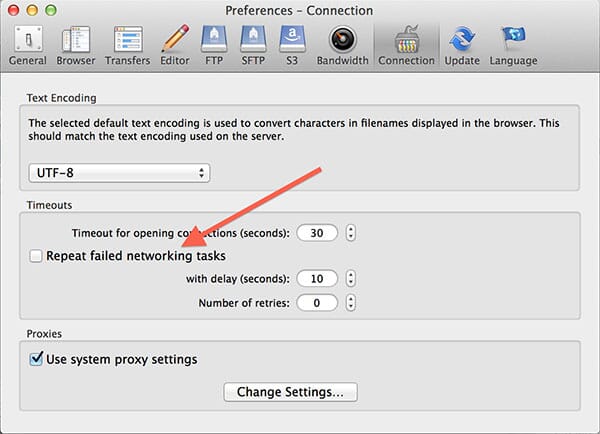
Upload file size limits
Files such as videos and zips must not exceed a certain file size limit or the upload will fail. The maximum file size differs depending on the method of upload:
- FTP: 512 MB max files size
- S3: 512 MB max file size
- my.sirv.com: 300 MB max file size
- REST API: 80 MB max file size
Zip files
Zip can be a useful way of uploading images/folders. They will automatically unpack, maintaining their folder structure:
- If the zip file has only one top level folder, the contents will be extracted into that folder.
- If the zip file has more than one top level folder or files, the contents will be extracted into a new folder using the zip's filename.
If a folder with the same name already exists, the contents will be added to the existing folder. If a file with the same name already exists, it will be overwritten.
Zip size limit
Zip files larger than a certain size will not unpack. If your zip exceeds the limit, break it into smaller zips.
Maximum file size to unpack a zip:
- 1 GB: Enterprise & Business 200+ accounts
- 512 MB: Business 5-100 accounts
- 256 MB: Free accounts
Limits for zip contents:
- Maximum number of files inside: 5,000
- Maximum depth of folder levels: 3
If you have a slow or unstable internet connection, zip uploads may fail. You can configure S3 and FTP to be resumable, so that partially uploads files continue uploading where they left off.
Archives must be in ZIP format (.zip). Sirv cannot extract files in proprietary formats such as RAR (.rar).
Disable zip unpacking
If you don't want zips to be automatically unpacked and deleted, change your account settings to disable unpacking and/or deletion:

Downloading images
To download files from your Sirv account, either right-click the file/folder or select multiple files/folders and click "Download". Sirv will package all the files into a zip file and commence the download.
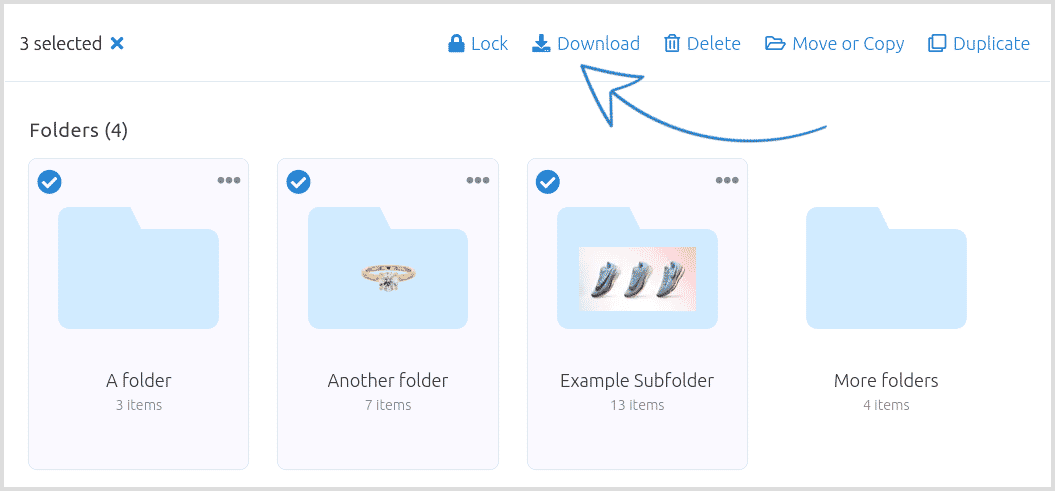
Downloads are limited to 4,000 files and 512MB per zip file (whichever is greater). The zip will not be generated if either limit is exceeded.
You can also download files by FTP or S3. Each has a limit on the number of downloads per hour.
If you only need to download one file, you can append ?dl to the file URL.

